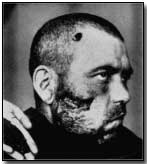Encyclopedia - Shrapnel
 Shrapnel consisted of a
hollow shell which was packed internally with (typically) small steel balls
or lead, together with an amount of gunpowder, and was the most common form
of artillery deployed in 1914.
Shrapnel consisted of a
hollow shell which was packed internally with (typically) small steel balls
or lead, together with an amount of gunpowder, and was the most common form
of artillery deployed in 1914.
Managed by a timed fuse shrapnel was designed to explode while in mid-air above the enemy's trench positions. The rapid dispersal of the shell's contents, be it lead or steel, was designed to cause maximum casualties with minimal artillery effort; in essence a modern-day equivalent of the previous century's grapeshot.
Inevitably shrapnel was best utilised against troops advancing across open land rather than against those huddled in more or less effective trench dugouts; in this case high explosive shells - which broke into many fragments upon detonation - were generally preferred.
Although shrapnel was used to cut down enemy barbed wire it was generally regarded as unsatisfactory for the task.
The wide deployment of shrapnel as a weapon during the First World War mandated that the light cloth caps as worn by infantrymen in 1914 be replaced by steel helmets which afforded at least some protection against the rain of steel or lead.
Photograph courtesy of Photos of the Great War website
A Kite Balloon was an observation balloon controlled by a cable from the ground.
- Did you know?
